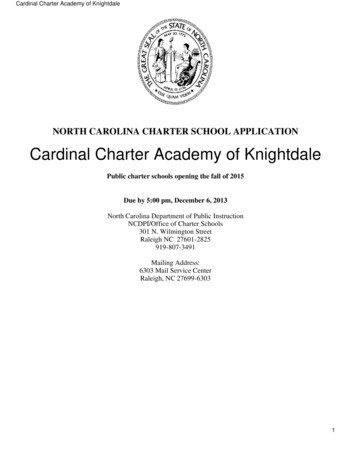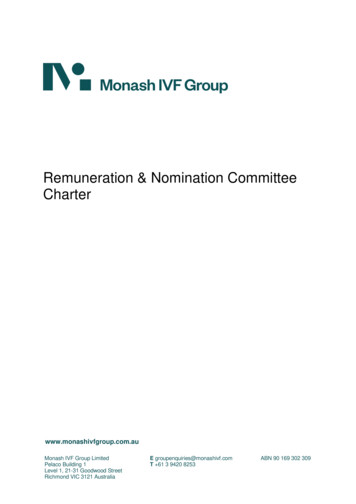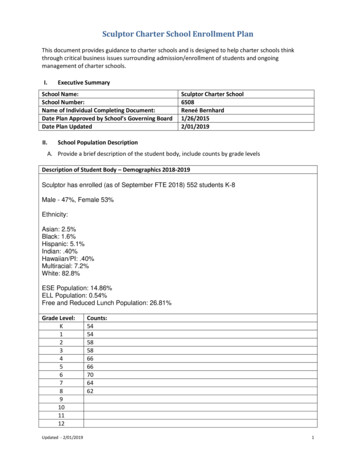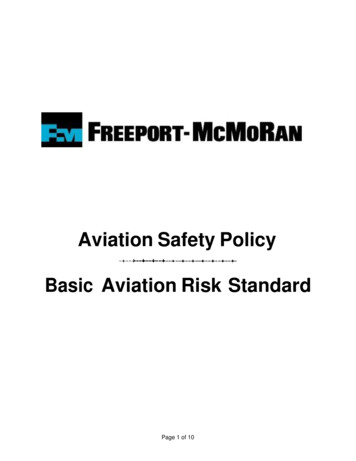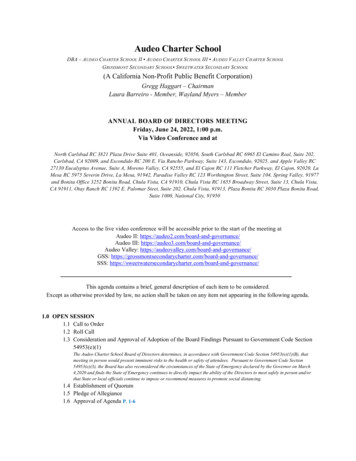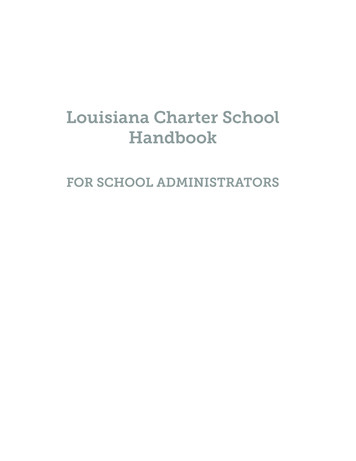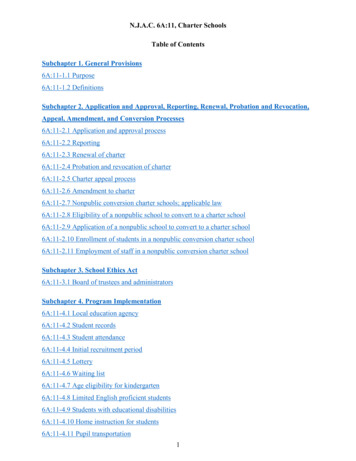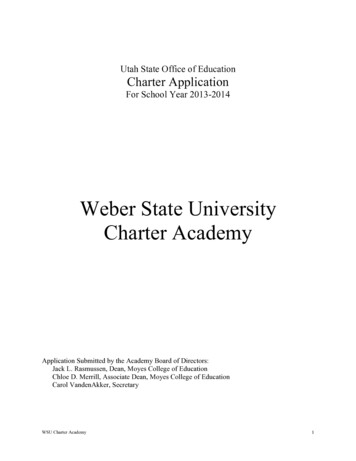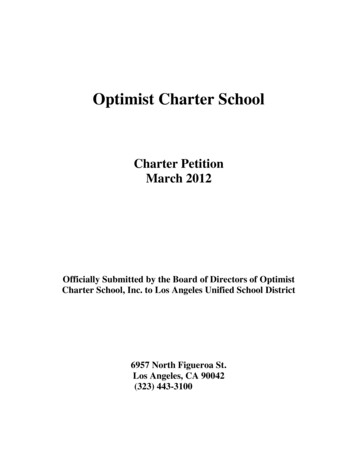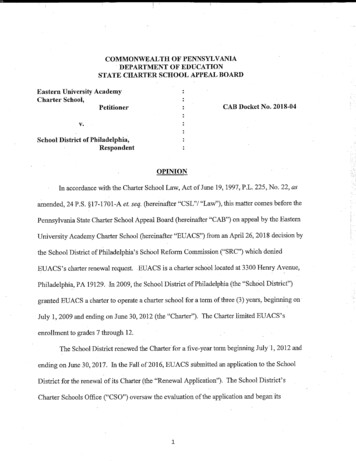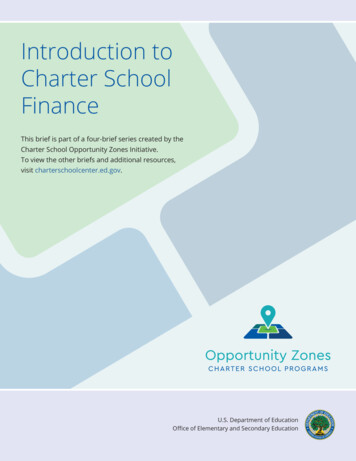
Transcription
Introduction toCharter SchoolFinanceThis brief is part of a four-brief series created by theCharter School Opportunity Zones Initiative.To view the other briefs and additional resources,visit charterschoolcenter.ed.gov.U.S. Department of EducationOffice of Elementary and Secondary Education
Introduction to Charter School FinanceThis brief provides an introduction to charter school finance for Opportunity Zone investors new to the charterschool field. Specifically, this brief summarizes the primary drivers of charter school income and expenses andoffers insights into charter school facility investing and financing sources. For additional information, see the briefon The Business of Charter Schools.Primary Drivers of Charter School Operating Income and ExpensesThe following descriptions provide an overview of the income and expenses of a theoretical charter school. Realworld cases may vary considerably depending on their jurisdiction and other circumstances.How charter schools get their fundingLike other public schools, charter schools receive per student funding from federal, state, and local sources. Stateand local funding make up the majority of charter schools’ revenues – in excess of 90 percent in most cases. Basefunding makes up the majority of state funding and covers general per pupil educational expenses. It is calculatedas a function of the state’s per pupil funding allocation multiplied by the school’s enrollment or average dailyattendance.In addition to base funding, schools may receive categorical funding to offset costs for particular student groupsor school functions. These categorical funds include Title I funds in support of low-income students, funds forstudents with special education requirements, or meal programs through the U.S. Department of Agriculture.Some states provide additional funds to support school facility expenses, for instance in the form of per pupilreimbursement, grants, or dedicated loan facilities. Lastly, many schools also engage in fundraising, which caninclude private donations and grants.Risks to achieving projected revenue are twofold: 1) falling short on projected enrollment through insufficientrecruitment efforts or student attrition, and 2) reductions in per student funding levels from public sources.How charter schools spendBy far the biggest expense for charter schools is staffing, which depending on school size can range from 60 to70 percent of total income. Instructional positions tend to be more scalable and make up approximately 65 to 80percent of total staffing expenses, while administrative and leadership positions make up the rest. The secondlargest expense is typically occupancy, which comprises all costs related to operating and renting or owning aschool building and may account for as much as 15 to 20 percent of a charter school’s income. Administrationor management fees (5 to 10 percent) and charter authorizer fees (1 to 5 percent, if they exist) are the nextlargest expense categories, followed by meal program expenses and contracted services such as accounting ortransportation, books and supplies, and other administrative costs.During times of financial austerity, many schools tend to adjust staffing expenses, for instance through layoffs,furloughs or salary freezes, or to outsourcing services such as meals or maintenance. Long-term obligations suchas real estate debt or lease arrangements are typically not an adjustable expense and are therefore carefullyweighed before making a commitment.Introduction to Charter School Finance 2
Charter School Investing and Capital FundingMost charter schools rely on private-sector capital to fund facility development.Assessing investment potentialWhen evaluating a charter school’s investment potential, lenders and investors typically undertake a documentreview similar to other sectors, including audited financial statements, quarterly financial statements (budget-toactual comparison), tax returns, current year budget, and cashflow projections. Tied to this analysis is the review ofenrollment and academic performance data, which form the basis of the school’s finances. Many lenders considerreal estate expenses sustainable if they are below 15 percent of income, depending on local market dynamics.Financeable project leverage ranges from 75 up to 90 percent loan-to-value ratio. Lenders also require a debtservice (or lease) coverage ratio of at least 1.10 to 1.20x. Other covenants that lenders require measure liquidity (acommon requirement is 30 or more days of cash on hand) and leverage.Types of capital funding availableThe following table gives an overview of financing options most commonly used by charter schools. With 3 billionin average annual originations between 2015 and 2018, the tax-exempt bond market is the largest source of debtcapital. Community Development Financial Institutions (CDFIs) have long been lenders to charter schools and viewthem as mission aligned, particularly when serving lower income communities. In addition to term loans, whichare described below, CDFIs have provided approximately 500 million in permanent debt to fund charter schoolfacilities using the Bond Guaranty Program. Commercial banks are increasingly active in the market, although nopublicly available data exist on the total lending volume. Table 1 on the next page details the attributes, costs, andbenefits of each of these sources and how they relate to each other.Additional funding sourcesIn addition to the funding sources listed above, charter schools can access New Markets Tax Credits (NMTCs) ifthey are located in qualifying, lower income census tracts. NMTCs are important, albeit highly competitive fundsthat provide quasi-subsidy between 15 and 20 percent of the total amount of NMTCs in underserved communities.Between 2002 and 2019, NMTCs provided 3.2 billion in allocation to charter school projects. Moreover, the U.S.Department of Education awarded approximately 323 million through its Credit Enhancement Program to eligibleorganizations who can use the funds to credit enhance charter school transactions, including lease and loanguarantees.Introduction to Charter School Finance 3
Table 1. Attributes, Costs, and Benefits of Typical Charter School Facility Funding SourcesTax Exempt BondFinancingCommercial BankLoansCDFI Term LoansLoan AmountGreater than 10 million 5 to 20 millionUp to 10 millionMaximum Term35 years15 to 20 years7 yearsMaximum Amortization35 years30 years25 yearsBenefits to ChartersHigherLowerLowerInterest RateLowerLowerHigherSchool DevelopmentStageGrowth, maturity, andexpansionGrowth, maturity, andexpansionNew start, growth,maturity, expansionDemographics StudentPopulationNo restrictionNo restrictionLower income censustractsClosing iveConservativeMore flexibleTransaction CostsHighMediumLow to mediumInterest Rate Risk1LowMediumHighLoan to Value 100% 70% 90%May be unfamiliarwith charter schoolMission alignmentAttributeCosts and BenefitsOther”Interest rate risk” here refers to the interest rate uncertainty that schools will face if debt needs to be refinanced. For instance, a5-year loan amortizing over 25 years will have a balloon payment at maturity (the end of year 5), which will need to be refinanced at anunknown future interest rate. The possibility that the interest rates move up is the interest rate risk.1Introduction to Charter School Finance 4
U.S. Department of EducationOffice of Elementary and Secondary Education
Charter School Finance . on The Business of Charter Schools. Primary Drivers of Charter School Operating Income and Expenses . school building and may account for as much as 15 to 20 percent of a charter school's income. Administration or management fees (5 to 10 percent) and charter authorizer fees (1 to 5 percent, if they exist) are the .
